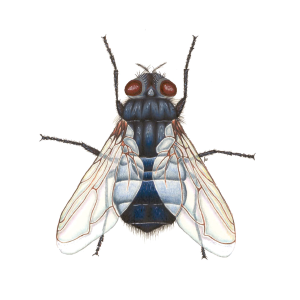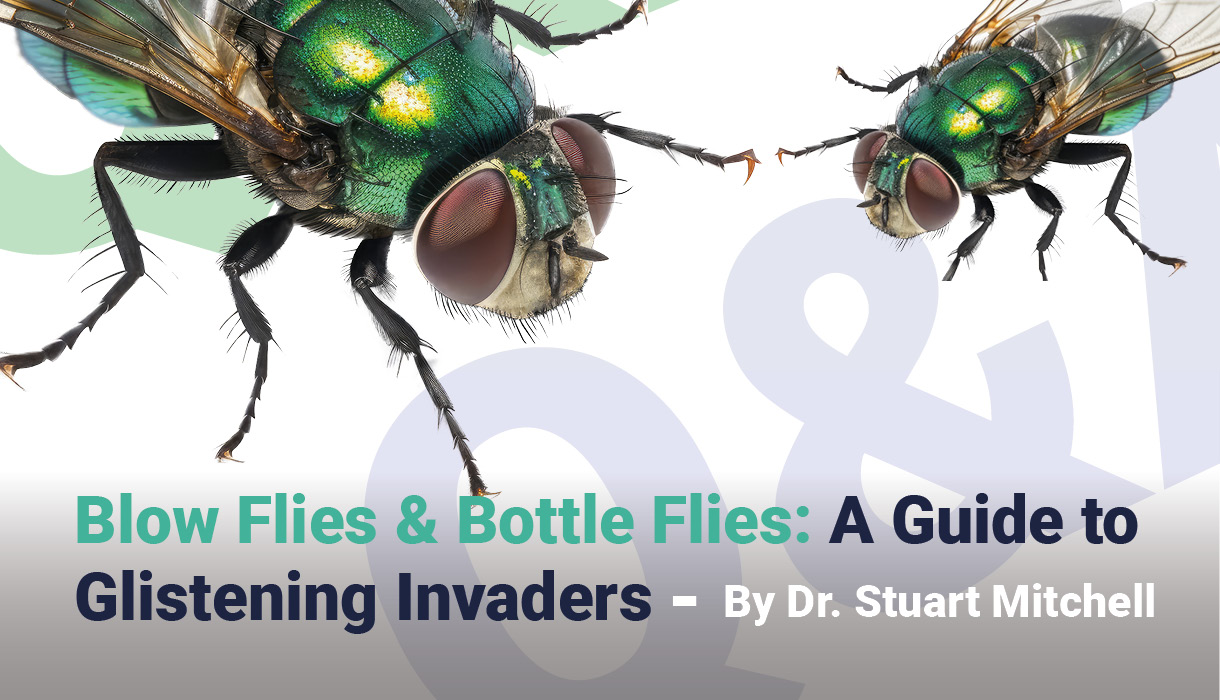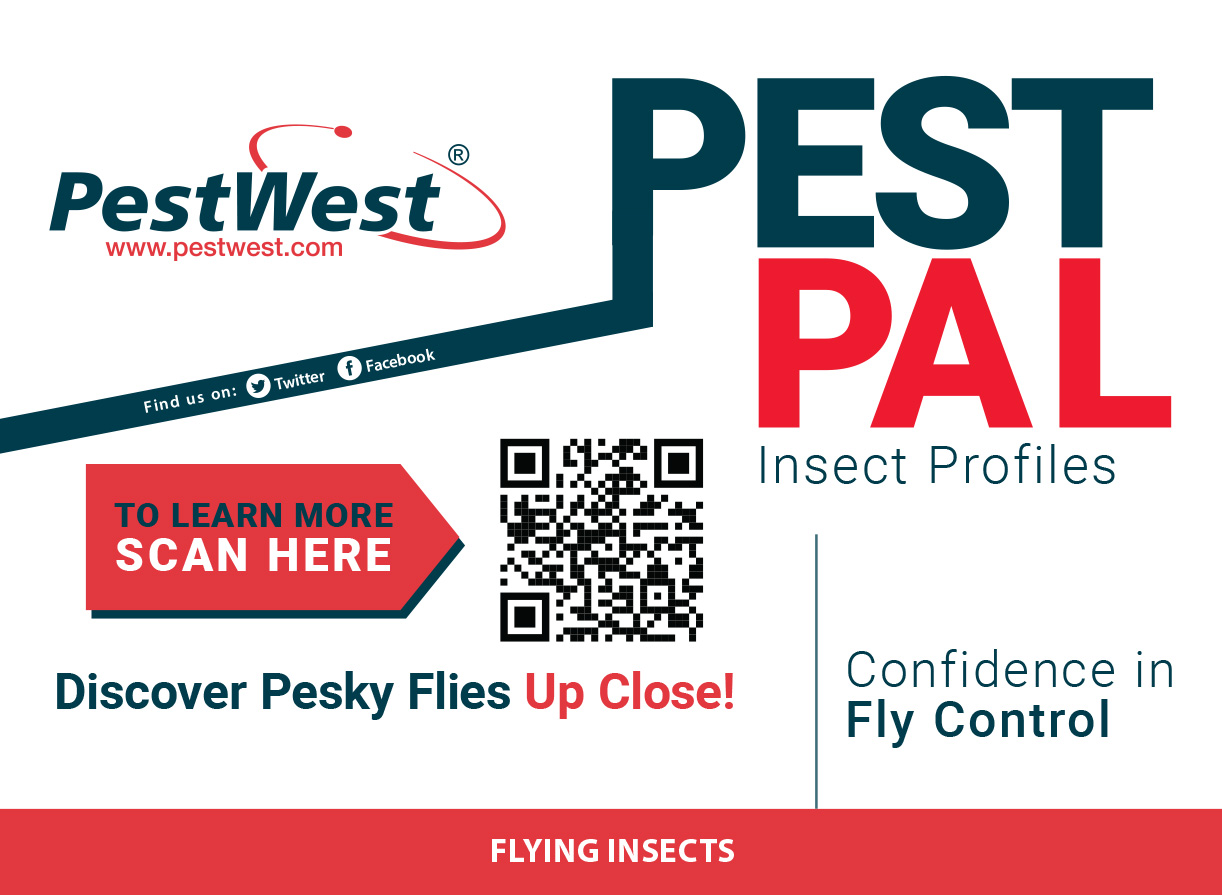While aesthetically intriguing with metallic sheen, Blow flies and Bottle flies are repugnant in and around human concerns. These fly species are saprophages, feeding upon dead and decaying organic matter. In the order of insect succession, adult flies are often first to arrive on a dead animal. Within minutes to hours after death, these fly species are attracted to the initial gases and fluids produced by a decomposing animal. Transferring disgusting decomposition to your tasty “tater” salad!
What is a Blow fly and Bottle fly?
Familiar standouts by their metallic black, green, blue, and bronze, Blow flies and Bottle flies are 1/8” to 5/8” long. These fly species are in the Family, Calliphoridae (meaning “bearer of beauty”). A notable differentiation is female Blow flies and Bottle flies are larger than the males, so their two compound eyes appear to be spaced apart. The males have compound eyes that appear to be touching.
Where do Blow flies and Bottle flies lay eggs?
Drawn to dead animal or carrion putrefaction, adult female flies lay eggs on and in decomposing matter. Other areas include garbage inside containers such as dumpsters. Ensure that containers are sealed and managed. Dispose of wastes properly.
How long do Blow flies and Bottle flies live?
These flies undergo 4 stages of development or complete metamorphosis. Adults live up to 3 weeks, depending upon environmental conditions and lack of predation.
- Eggs: Females lay eggs on decomposing matter. For Greenbottle fly, up to 180 eggs can be laid at one time. Eggs hatch into larvae (maggots) within 24 hours.
- Larvae (maggots): Larvae feed on decay and inside lesser decay (undergoing 3 larval stages). Notably, forensic entomology involves using larvae to determine details of death.
- Pupation: Mature larvae seek drier locations to pupate. Usually within the top few inches of soil.
- Adults: Emerge from pupal cases or undergo eclosion.
- Emergence: The adult fly inflates a specialized structure called the ptilinum organ, which is a sac-like structure within the head. This allows the fly to break through the pupal case.
- Hardening and darkening (sclerotization): Once successfully out of the pupal case, the adult fly is soft, pale, vulnerable, and cannot take flight. Over the next few hours, the fly’s cuticle (exoskeleton) hardens and darkens (sclerotization).
- Wing expansion: Wings (crumpled) expand to full size. The adult fly pumps hemolymph (insect equivalent to blood) into the wing veins. Once fully expanded, the wings will harden.
- Body expansion: The adult fly may pump hemolymph to expand other body parts (including abdomen).
- Maturation: Over a short time, the adult fly undergoes further internal changes, such as reproductive organ development. Ensuring short-lived flies can reproduce.
- Grooming: The adult fly spends time grooming. Cleaning its body, wings, and legs to remove any remaining pupal case or debris from the environment.
- First Flight: Once the wings have hardened and the body is fully expanded, the adult fly takes the first flight. Now a free-ranging fly.
Do Blow flies and Bottle flies bite?
These fly species do not possess mouthparts that pierce skin and do not bite. Mouthparts are structured for sponging up nutrients from decomposing matter. Blow flies and Bottle flies “taste-test” by regurgitating saliva onto appetitive food sources and then sponge up the predigested soupy mixture.
Are Blow flies and Bottle flies dangerous?
While not harmful through bites or stings, these fly species can be a nuisance. These flies can transfer filth and pathogens to food causing foodborne illnesses. There is also possibility of myiasis (an infection of fly larvae or maggots). Although of medical benefit, Greenbottle fly maggots are used in a wound treatment called maggot debridement therapy (MDT).
How to get rid of Blow flies and Bottle flies?
- Locate and eliminate: Ensure any dead animals are properly removed and disposed-of. Inspect flat roofs for dead birds.
- Garbage: Ensure that all garbage and rich organic materials (such as dog feces) are routinely removed. These are areas where adult female flies lay eggs and flies feed.
- Maintain dumpsters and garbage receptacles: Keep dumpsters, garbage cans, and recycle bins clean and in good condition. Position dumpsters at least 50 feet from, and upwind of, the building. These practices minimize Blow fly and Bottle fly attraction, feeding, and reproduction.
- Secure storage: Store garbage in well-sealed containers to keep female flies out of potential reproductive materials. Use puncture and tear resistant trash bags.
- Use screens: Install and maintain window and door screens to restrict fly entry into homes and businesses.
- Install air curtains: Install and maintain air curtains with appropriate air-velocities. These are 3 meters/second for service doors and drive-through-windows and 9 meters/second for overhead doors. Blow flies and Bottle flies can fly 4 to 5 mph, so air curtains prevent them from entering buildings.
- Use light traps: Install numerous light traps to both monitor and control fly populations.
- Bring out the heavy “flytillery”: Install the Nemsis® Quattro, Titan Alpha®, and Titan® 300. When Blow flies and Bottle flies invade, these suspended fly killers are a formidable line of defense. Empowered to decimate large populations of flies with silent high-voltage grids.
- Other methods: Labeler use of insecticides, fly swatters, and sticky traps can be used to kill and control flies.
Blow flies and Bottle flies are fascinating sorts of decomposers in the natural world, but when in conflict with humans, they become a pathway for filth to food. Understanding and proactive measures can control these pestiferous perpetrators. Ensuring an environment protected from nuisance and contamination. For further illumination regarding these shimmering pests, connect with PestWest at 941.358.1983 or drop a line at customerservice@pestwest.com.
Blow fly insect Id

BLOW fly
Calliphora spp.
Features
Thorax and abdomen are black/blue in colour and often with a metallic appearance. Wingspan 18-20mm.
Control
All PestWest fly killers are a very effective step in controlling these pests.
Tap the button below to dive into ‘
Blow Flies & Bottle Flies: A Guide To Glistening Invaders,’ an insightful article on Fruit Flies by our expert, Doc.
More flies IDs






